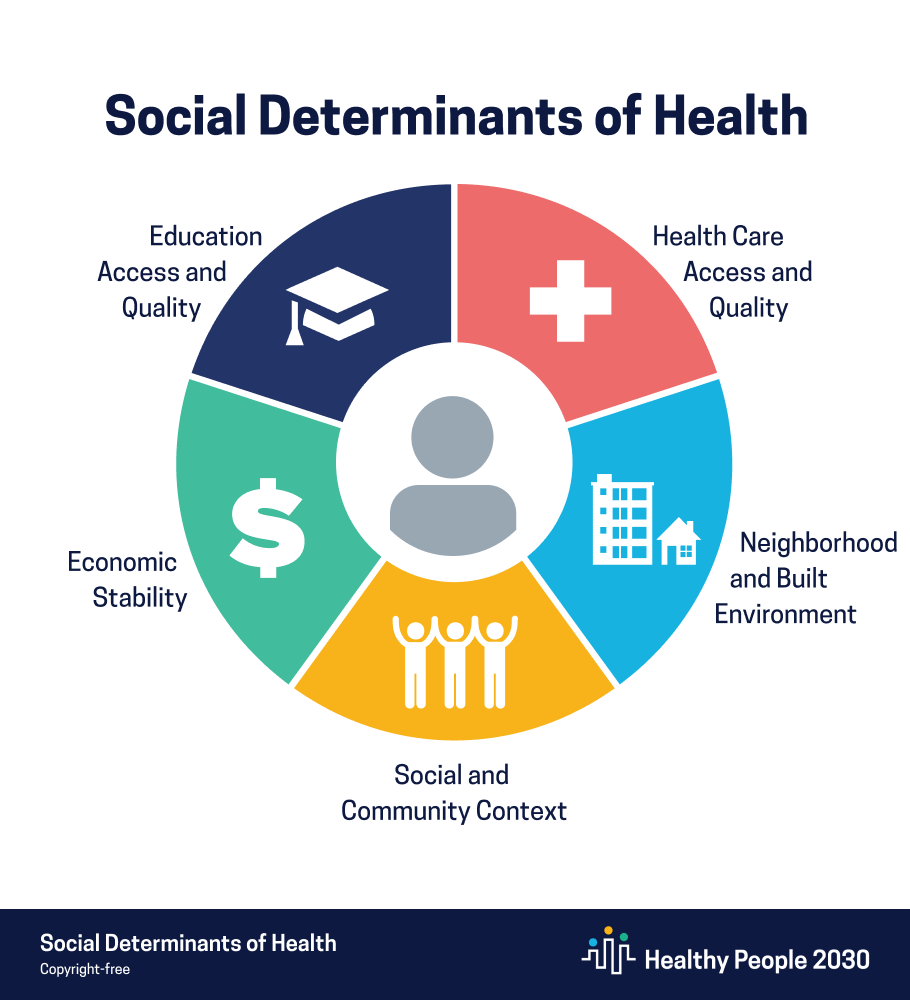Where we are born, work, live, learn, play, build and age significantly impacts our quality of life and health status. These conditions are known as the social determinants of health (SDOH), and their effect is so substantial that Healthy People 2030 has made SDOH one of five overarching objectives to build healthy futures for all life stages. Healthy People 2030 further categorizes SDOH into five domains: economic stability, education access and quality, healthcare access and quality, neighborhood and built environment and social and community context (see figure below).
Growing recognition that SDOH can have a greater influence on an individual’s health and well-being than clinical care has led to increased activity in this space. For example, a recently launched Congressional SDOH Caucus will explore opportunities to coordinate and improve the impact of federally funded SDOH-related services. Due to inequities older adults may already experience, including those related to nutrition, SDOH can greatly impact this population. Here, we identify opportunities to build improved nutrition equity for older adults under the Healthy People 2030 Framework and Goals.
Economic Stability: The Healthy People 2030 general goal for economic stability is to help people earn steady incomes that allow them to meet their health needs. When individuals are economically unstable, they have fewer resources for healthy food, healthcare, medical expenses, safe housing and other basics.
Older adults have been greatly impacted by the COVID-19 pandemic and have experienced unprecedented rates of unemployment. In 2019, the U.S. unemployment rate was only 3.5 percent, with adults ages 55 and older at 2.5 percent. But between January 2020 and May 2021, unemployment for adults ages 55 and older peaked at 15.4 percent for women and 12.1 percent for men. The high rates of unemployment among older adults increases their risk of poverty and food insecurity.
‘One in three older adults reporting material hardship as a result of the pandemic.’
Poverty impacts 1 in 10 individuals living in the United States, and frequently leads to individuals choosing between necessities like food, utilities, transportation, prescriptions and medical care. Rates of poverty are not equally distributed among populations. Black, Indigenous and Latino communities, as well as households with children and older adults are at greater risk.
During COVID-19, a nationally representative survey documented one in three older adults reporting material hardship as a result of the pandemic, and identified racial and socioeconomic disparities in hardship as well as heightened vulnerability for older adults in poor health and with functional or cognitive impairments.
Nutrition Equity Opportunity: Enroll older adults in food and nutrition programs that support access to healthy foods, including:
- Congregate and home-delivered meal programs supported by the Older Americans Act—click here to find a state program.
- Supplemental Nutrition Assistance Program (SNAP) benefits to buy food—click here to find a state program. It is important to note that the Biden Administration recently announced a significant 25 percent increase in the monthly average benefit in SNAP for all 42 million individuals served by the program.
Healthcare Access and Quality: The general goal in Healthy People 2030 for healthcare access and quality is to increase access to comprehensive, high-quality healthcare services. Older adults ages 65 and older or individuals living with a disability are eligible to enroll in Medicare, including the public-private option known as Medicare Advantage.
Beneficiaries enrolled in Medicare Advantage receive Medicare benefits through a private health plan. In addition to covering all Medicare benefits, most health plans also offer supplemental benefits at no extra cost to the beneficiaries. Recent legislative and regulatory changes have expanded the flexibilities to address SDOH in Medicare Advantage through supplemental benefits. As a result, there has been quick uptake by health plans in addressing SDOH.
Supplemental benefits are especially effective for enrollees that meet certain criteria, such as having a chronic condition, because benefits may be non-primarily health related. For example, benefits may include electronic payment cards to purchase food and produce and at-home meal delivery. The availability of these benefits is growing year over year, with 57 percent of Medicare Advantage plans offering a meal benefit in 2021.
Nutrition Equity Opportunity: Encourage older adults enrolled in Medicare Advantage to use available supplemental nutrition and food-related benefits. Click here to compare Medicare Advantage plans in your area.
Social and Community Context: The Healthy People 2030 general goal for social and community context is to increase social and community supports. The goal specifically seeks to increase the proportion of adults who talk to friends and family about their health. Social and community context is critical for older adults due to the increased risk of isolation. Because social isolation may contribute to depression and decreased appetite, older adults are further at risk for poor nutrition or malnutrition. Therefore, it is important to ensure regular screening and intervention for malnutrition across the continuum of care, particularly at the community level.
Fostering a community where people feel valued rather than isolated increases quality of life among older adults. The COVID-19 pandemic spurred innovation in social isolation prevention initiatives, including door-to-door transport and partnerships with community organizations.
‘Fostering a community where people feel valued rather than isolated increases quality of life among older adults.’
The need for more community-based attention on malnutrition and food insecurity is underscored by a new improvement activity in the recent Centers for Medicare and Medicaid Services (CMS) Medicare Physician Fee Schedule Proposed Rule. As part of the Merit-based Incentive Payment System (MIPS), CMS proposes an improvement activity—Achieving Health Equity—focused on food insecurity and nutrition risk identification/treatment.
In the proposed rule, CMS stated, “We believe this activity has the potential to improve clinical practice or care delivery and is likely to result in improved outcomes, because ameliorating food insecurity and malnutrition leads to better health outcomes.”
Nutrition Equity Opportunity: Engage CMS and offer comments on the proposed rule to highlight the importance of food insecurity and malnutrition prevention and intervention.
Social determinants of health greatly impact every person at every life stage. SDOH have the potential to improve health outcomes and nutrition or serve as a barrier to healthy aging and living a full and active life. Older adults are potentially at a greater risk for being negatively impacted by SDOH due to the COVID-19 pandemic. During the pandemic, older adults experienced the highest rates of unemployment, poverty, food insecurity, and social isolation in recent times.
However, there are opportunities to strengthen nutrition equity by connecting older adults to available federal nutrition programs, Medicare Advantage supplemental benefits and regular screenings and interventions for malnutrition and food insecurity. By focusing on improved economic stability, access to quality healthcare and increasing social interactions, older adults can live a full and healthy life.
Additional Resources
Better Medicare Alliance—State of Medicare Advantage Report 2021
Lacresha Johnson, MS, RDN, LDN, is a health policy consultant with the Abbott Nutrition Division of Abbott in Columbus, Ohio. Kaitlyn Saal-Ridpath, JD, MPH, is a policy associate at the Better Medicare Alliance in Washington, DC.














